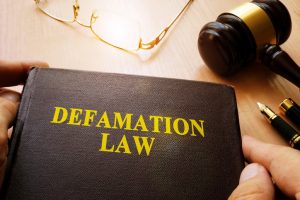Defamation: What You Need to Know
 With the rise of social media, there is no longer a traditional “reasonable expectation of privacy” in publicly available information. The average social media user must always assume that what they say is “on the record.” The risk of defamatory content reaching millions has increased immensely, and the only way to protect yourself is to understand which personal remarks are acceptable and which cross the line into defamation.
With the rise of social media, there is no longer a traditional “reasonable expectation of privacy” in publicly available information. The average social media user must always assume that what they say is “on the record.” The risk of defamatory content reaching millions has increased immensely, and the only way to protect yourself is to understand which personal remarks are acceptable and which cross the line into defamation.
The term “defamation” covers any untrue statement that damages another’s reputation. A defamatory statement that is made in writing and published is referred to as “libel.” On the other hand, if the statement is only made orally, it is considered “slander.”
Defamation is categorized as a civil wrong, a tort. Therefore, any individual who suffers damage caused by a defamatory statement may sue the person who made the statement. For as long as defamation law has existed in the United States, both freedom of speech and the right of an individual to avoid defamation have been of great concern. Defamation law attempts to ensure the right of individuals to speak the truth about others while also offering recourse to those who suffer damage as the result of false statements made about them.
Elements of Defamation
Although defamation laws vary among states, there are accepted standards common to all defamation laws. Generally speaking, in order to prove defamation, an individual must show the following elements:
- Statement: The statement must be spoken, written, or otherwise expressed in some manner. Spoken words often fade more quickly from memory, and for this reason, slander is often considered less harmful than libel.
- Publication: In order for a statement to be published, a third party must see, hear, or read the defamatory statement. A third party is someone other than the person making the statement and the individual subject of the statement. Contrary to the traditional meaning of the word “published,” a defamatory statement does not necessarily need to be printed in a book. Rather, a statement made on television or written on someone’s door may be considered published. Similarly, blog comments and social media missives are also considered published.
- Injury: To succeed in a defamation lawsuit, one must prove the statement has caused injury. Specifically, the statement must have hurt the reputation of the subject of the statement. For example, a statement has caused injury if the subject of the statement has lost their job as a result of the statement.
- Falsity: A statement cannot be defamatory unless it is false. A true statement, no matter how harmful, is not considered defamation in the eyes of the law. Additionally, statements of opinion are not considered false because they are the subjective ideas of the speaker.
- Unprivileged: Finally, to be considered defamatory, the statement must be unprivileged. Whether a statement is privileged or not is a policy decision determined by lawmakers. Lawmakers must weigh the need to avoid defamation against the importance of allowing the statement to be freely made. For example, statements made while testifying at trial are classified as privileged. Therefore, when a testifying witness makes a false and injurious statement, the witness will be immune from a defamation lawsuit.
Public Figures Receive Less Protection
Our government places high priority on the public being allowed to speak freely about elected officials and other public figures. Therefore, people in the public eye receive less protection from defamatory statements and face a higher burden of proof when attempting to prove their defamation case. In addition to the elements listed above, a public figure who pursues a defamation claim must also prove that the statement was made with “actual malice.”
“Actual malice” was defined by the Supreme Court in Hustler v. Falwell. In Falwell, the Court held that certain statements that would otherwise be defamatory were protected by the First Amendment of the United States Constitution. The Court reasoned that “the sort of robust political debate encouraged by the First Amendment is bound to produce speech that is critical of those who hold public office or those public figures who are intimately involved in the resolution of important public questions….” The Court’s decision effectively means that public figures can win a defamation suit only when the statement made against them is not an honest mistake and is in fact published with the actual intent to harm the public figure.
Connect with Top-rated Attorneys Near You
Latest Article
What Is a Trust Fund? A Comprehensive Guide
A trust fund is a powerful tool that has stood the test of time. It is an essential instrument in modern wealth manageme... Read More
Arraignment: Meaning, Common Charges, & Process
Arraignment is a pivotal moment within the criminal justice system, marking the formal initiation of criminal proceeding... Read More
What Is Probable Cause? Definition and Examples
The Constitution protects you from being searched without a valid reason. But what exactly constitutes a valid reason? A... Read More
GETLEGAL®ATTORNEY DIRECTORY
Find Leading Attorneys in Your Area
NEED PROFESSIONAL HELP?
Talk to an Attorney
How It Works
- Briefly tell us about your case
- Provide your contact information
- Choose attorneys to contact you


